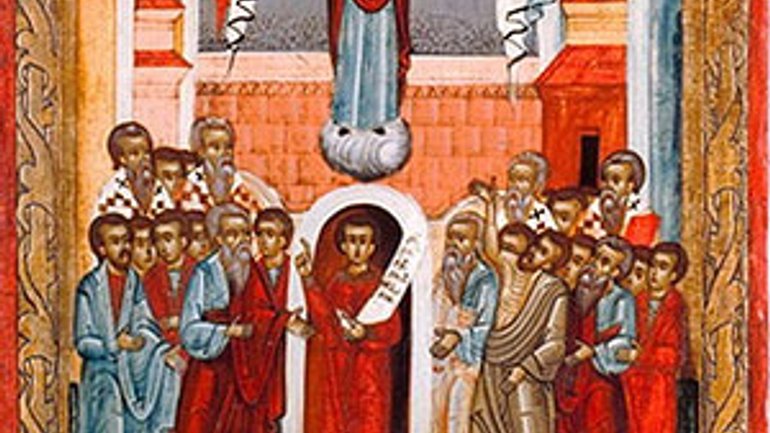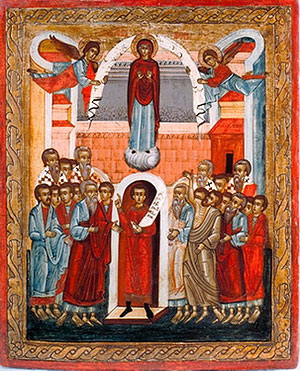Feast of Intercession Celebrated in Ukraine as Religious and National Holiday

 Of the feasts dedicated to the Mother of God, the Feast of the Protection or Intercession of Our Most Holy Lady Theotokos and Ever-Virgin Mary deserves special attention. In Ukraine, it is celebrated on October 14 as a religious, national, and family holiday. Its popular name is also the “Third Most Pure One.” It was established as an expression of gratitude for the protection of Constantinople by the Mother of God.
Of the feasts dedicated to the Mother of God, the Feast of the Protection or Intercession of Our Most Holy Lady Theotokos and Ever-Virgin Mary deserves special attention. In Ukraine, it is celebrated on October 14 as a religious, national, and family holiday. Its popular name is also the “Third Most Pure One.” It was established as an expression of gratitude for the protection of Constantinople by the Mother of God.
According to Eastern Orthodox Sacred Tradition, the apparition of Mary the Theotokos occurred during one of the sieges of Constantinople at the Blachernae church in Constantinople (modern-day Istanbul) where several of her relics (her robe, veil, and part of her belt) were kept. On Sunday, October 1, at four in the morning, St. Andrew the Blessed Fool-for-Christ, his disciple, St. Epiphanius saw the dome of the church open and the Virgin Mary enter, moving in the air above him, glowing and surrounded by angels and saints. She knelt and prayed with tears for all faithful Christians in the world. The Virgin Mary asked Her Son, Jesus Christ, to accept the prayers of all the people entreating Him and looking for Her protection. Once Her prayer was completed, She walked to the altar and continued to pray. Afterwards, She spread Her veil over all the people in the church as a protection. As the result the enemies withdrew and the city was rescued.
Some historians state that St. Andrew lived under Emperor Leo I (457-474 Anno Domini). But according to the majority of them, he lived at the time of Emperor Leo the Wise (886-911).
The feast of the Protection of the Theotokos was a local feast in Greece and after the fall of Constantinople in 1453, they even stopped to celebrate it. The feast’s service includes an all-night vigil after the pattern of the great feasts but does not belong to the 12 great feasts of the Liturgical year.
The cult of the Mother of God as the Intercessor and Patron got firmly established among the Ukrainians: Ukrainian princes, kings, Cossacks, and hetmans chose the Mother of God as their Patron and Guardian.
Prince Yaroslav the Wise in 1036 defeated the Pechenegs and built in Kyiv the Church of Assumption at the Golden Gates out of gratitude. In 1037, in the Church of Assumption, he entrusted the whole nation to the guardianship of the Mother of God. Prince Mstyslav during his campaign against Circassians promised to build a church in honour of the Mother of God if She helps him to defeat the enemy. He defeated them and fulfilled his promise. Prince Volodymyr Monomakh in his memoirs wrote that he defeated the Polovtsi thanks to God and the Most Holy Virgin. In 1103 before the campaign against the Polovtsi, our princes and dukes made vows to God and the Holy Virgin Mary. Prince Ihor Sviatoslavovych after his escape from captivity, came to bow to a wonder-working icon of the Mother of God to thank her for the help. The Galician King Danylo after his successful campaign to the Czech land hurried to the icon of the Mother of God in Kholm to thank Her, bow down and bring rich gifts. Some Ukrainian princes’ seals contained small icons of the Mother of God or prayers to her on their.
Zaporozhian Cossacks built in their Sich host a Church in honor of the Protection of the Holy Mother of God which contained an icon of her veil. There was an inscription on the icon “I will cover my people” and another inscription on a ribbon under the icon “We pray: cover us with Your Holy Veil and deliver us from evil.” Before their military campaigns, the Cossacks held public prayers to their patroness. Upon their successful return, they thanked the patroness.
The Ukrainian Insurgent Army on May 30, 1947, declared the feast to be its holiday.









